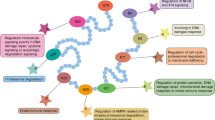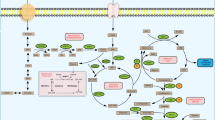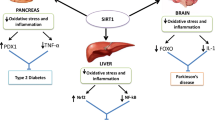Abstract
The ubiquitin C-terminal hydrolase (UCH) is a subfamily of deubiquitinating enzymes, which consists of four members: UCH-L1, UCH-L3, UCH37, and BRCA1-associated protein-1. Although there is growing evidence that UCH enzymes and human malignancies are closely correlated, there have been few studies on UCH37, especially on its interactions with other proteins. In the current study, a functional proteomic analysis was performed to screen UCH37-interacting proteins in hepatocellular carcinoma (HCC), and glucose-regulated protein 78 was identified as one interacting with UCH37, which was confirmed by co-immunoprecipitation and confocal laser scanning microscopy analysis, suggesting that their interaction could provide a new insight into the mechanism of HCC.





Similar content being viewed by others
Abbreviations
- 2D:
-
Two-dimensional
- co-IP:
-
Co-immunoprecipitation
- DUBs:
-
Deubiquitinating enzymes
- FBS:
-
Fetal bovine serum
- FITC:
-
Fluorescein isothiocyanate
- GRP78:
-
Glucose-regulated protein 78
- HCC:
-
Hepatocellular carcinoma
- hINO80:
-
Human Ino80 chromatin-remodeling complex
- HSPs:
-
Heat shock proteins
- IPTG:
-
Isopropyl β-d-thiogalactoside
- PBS:
-
Phosphate-buffered saline
- SD:
-
Standard deviation
- Ub:
-
Ubiquitin
- UCH:
-
Ubiquitin C-terminal hydrolase
References
Hershko A, Ciechanover A (1998) The ubiquitin system. Annu Rev Biochem 67:425–479
Pickart CM (2001) Mechanisms underlying ubiquitination. Annu Rev Biochem 70:503–533
Finley D, Ciechanover A, Varshavsky A (2004) Ubiquitin as a central cellular regulator. Cell 116(Suppl 2):S29–S32 (2p following S32)
Sridhar VV et al (2007) Control of DNA methylation and heterochromatic silencing by histone H2B deubiquitination. Nature 477(7145):735–738
Liu H et al (2009) Regulation of ErbB2 receptor status by the proteasomal DUB POH1. PLoS One 4(5):e5544
Singhal S, Taylor MC, Baker RT (2008) Deubiquitylating enzymes and disease. BMC Biochem 9(Suppl 1):S3
Larsen CN, Krantz BA, Wilkinson KD (1998) Substrate specificity of deubiquitinating enzymes: ubiquitin C-terminal hydrolases. Biochemistry 37(10):3358–3368
Yao T et al (2006) Proteasome recruitment and activation of the Uch37 deubiquitinating enzyme by Adrm1. Nat Cell Biol 8(9):994–1002
Schreiner P et al (2008) Ubiquitin docking at the proteasome through a novel pleckstrin-homology domain interaction. Nature 453(7194):548–552
Husnjak K et al (2008) Proteasome subunit Rpn13 is a novel ubiquitin receptor. Nature 453(7194):481–488
Yao T et al (2008) Distinct modes of regulation of the Uch37 deubiquitinating enzyme in the proteasome and in the Ino80 chromatin-remodeling complex. Mol Cell 31(6):909–917
Zediak VP, Berger SL (2008) Hit and run: transient deubiquitylase activity in a chromatin-remodeling complex. Mol Cell 31(6):773–774
Wicks SJ et al (2005) The deubiquitinating enzyme UCH37 interacts with Smads and regulates TGF-β signaling. Oncogene 24(54):8080–8084
Wicks SJ et al (2006) Reversible ubiquitination regulates the Smad/TGF-β signalling pathway. Biochem Soc Trans 34(Pt 5):761–763
Mazumdar T et al (2010) Regulation of NF-κB activity and inducible nitric oxide synthase by regulatory particle non-ATPase subunit 13 (Rpn13). Proc Natl Acad Sci USA 107(31):13854–13859
Fang Y, Fu D, Shen XZ (2010) The potential role of ubiquitin c-terminal hydrolases in oncogenesis. Biochim Biophys Acta 1806(1):1–6
Nishio K et al (2009) Crystal structure of the de-ubiquitinating enzyme UCH37 (human UCH-L5) catalytic domain. Biochem Biophys Res Commun 390(3):855–860
Amerik AY, Hochstrasser M (2004) Mechanism and function of deubiquitinating enzymes. Biochim Biophys Acta 1695(1–3):189–207
Soboleva TA, Baker RT (2004) Deubiquitinating enzymes: their functions and substrate specificity. Curr Protein Pept Sci 5(3):191–200
Nijman SM et al (2005) A genomic and functional inventory of deubiquitinating enzymes. Cell 123(5):773–786
Wang M et al (2009) Role of the unfolded protein response regulator GRP78/BiP in development, cancer, and neurological disorders. Antioxid Redox Signal 11(9):2307–2316
Zhang LH, Zhang X (2010) Roles of GRP78 in physiology and cancer. J Cell Biochem 110(6):1299–1305
Gonzalez-Gronow M et al (2009) GRP78: a multifunctional receptor on the cell surface. Antioxid Redox Signal 11(9):2299–2306
Dong D et al (2004) Spontaneous and controllable activation of suicide gene expression driven by the stress-inducible grp78 promoter resulting in eradication of sizable human tumors. Hum Gene Ther 15(6):553–561
Lee AS (2007) GRP78 induction in cancer: therapeutic and prognostic implications. Cancer Res 67(8):3496–3499
Dai RY et al (2009) p28GANK inhibits endoplasmic reticulum stress-induced cell death via enhancement of the endoplasmic reticulum adaptive capacity. Cell Res 19(11):1243–1257
Luk JM et al (2006) Proteomic profiling of hepatocellular carcinoma in Chinese cohort reveals heat-shock proteins (Hsp27, Hsp70, GRP78) up-regulation and their associated prognostic values. Proteomics 6(3):1049–1057
Jamora C, Dennert G, Lee AS (1996) Inhibition of tumor progression by suppression of stress protein GRP78/BiP induction in fibrosarcoma B/C10ME. Proc Natl Acad Sci USA 93(15):7690–7694
Xing X et al (2006) Overexpression of glucose-regulated protein 78 in colon cancer. Clin Chim Acta 364(1–2):308–315
Wang Q et al (2005) Overexpression of endoplasmic reticulum molecular chaperone GRP94 and GRP78 in human lung cancer tissues and its significance. Cancer Detect Prev 29(6):544–551
Zhang J et al (2006) Association of elevated GRP78 expression with increased lymph node metastasis and poor prognosis in patients with gastric cancer. Clin Exp Metastasis 23(7–8):401–410
Misra UK, Deedwania R, Pizzo SV (2006) Activation and cross-talk between Akt, NF-kappaB, and unfolded protein response signaling in 1-LN prostate cancer cells consequent to ligation of cell surface-associated GRP78. J Biol Chem 281(19):13694–13707
Park HR et al (2007) Glucose-deprived HT-29 human colon carcinoma cells are sensitive to verrucosidin as a GRP78 down-regulator. Toxicology 229(3):253–261
Chiou JF et al (2010) Glucose-regulated protein 78 is a novel contributor to acquisition of resistance to sorafenib in hepatocellular carcinoma. Ann Surg Oncol 17(2):603–612
Acknowledgments
The authors would like to thank the members of Prof. Xizhong Shen’s laboratory for their helpful discussion and critical reading of the manuscript, and the members of the Key Laboratory of Molecular Medicine (under the auspice of the Ministry of Education), Shanghai Medical School of Fudan University for their technical assistance, and Institutes of Biomedical Sciences, Fudan University for their confocal laser scanning microscopy. The study was partly funded by National Basic Research Program of China (2007CB936000), Major National Science and Technology Projects (2009ZX10004-301, 2008ZX10002-017), Shanghai Science and Technology Commission (10410709400, 10411950100), Shanghai Talent Development Fund (2009-035), National Nature Science Foundation of China (30872503, 81000968), China Postdoctoral Science Foundation Funded Project (20100480542), Innovation Foundation for Graduates of Fudan University (EYE152048) ,and the National Clinical Key Special Subject of China.
Conflict of interest
The authors have no financial conflicts of interest.
Author information
Authors and Affiliations
Corresponding authors
Electronic supplementary material
Below is the link to the electronic supplementary material.
Rights and permissions
About this article
Cite this article
Fang, Y., Mu, J., Ma, Y. et al. The interaction between ubiquitin C-terminal hydrolase 37 and glucose-regulated protein 78 in hepatocellular carcinoma. Mol Cell Biochem 359, 59–66 (2012). https://doi.org/10.1007/s11010-011-0999-7
Received:
Accepted:
Published:
Issue Date:
DOI: https://doi.org/10.1007/s11010-011-0999-7




